What Is The Difference Between TCP and UDP is one of the most common interview questions in any network job interview question? 🤔 Yes.
Apart from job interviews if you are doing port forwarding for your online gaming then also you will find the option to both TCP and UDP in your router.
With this guide, I will try to give the answer to the Difference Between TCP and UDP in both the full technical way and also try to explain non-technical users’ questions regarding this topic.
Without any further delay, let’s get started.
TCP (Transmission Control Protocol) is the best-known and most common protocol, and it works by assigning each packet a unique identifier and a sequence number. This tells the receiver which packet has arrived and which one to expect next.
When a packet reaches its destination, the receiver checks that everything is as intended and then fires an acknowledgment to the sender.
When the sender receives this, it sends the next packet. If a packet fails to arrive or arrives in the wrong order, the receiver won’t acknowledge it, so the sender tries again.
This two-way communication makes TCP very reliable but not particularly fast. UDP (User Datagram Protocol) doesn’t bother with unique identifiers or sequence numbers – it simply uses checksums to ensure the data it receives hasn’t been corrupted en route. This makes it much faster but also less reliable.
Let’s understand the Process of TCP communication with the below-mentioned diagram.
Here Sender (Your PC) wants to establish communication with a remote server (Ex:- gaming server or any other server or another PC) then it sends a synchronize (SYN) request to the receiver.
Once the receiver is seeing someone who wants to establish a connection then it will also try to negotiate the connection with the sender then the sender will acknowledge the connection which will help to establish the connection.
After establishing the connection, data transfer will start from both ends, and this whole process is called a TCP-Three-way handshake.
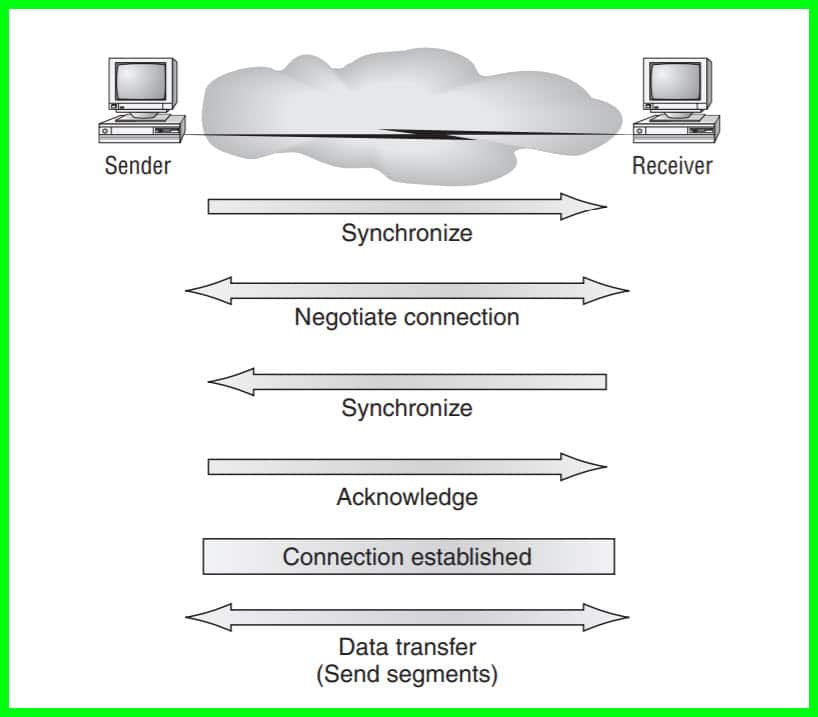
Before moving forward, I want to explain some important terms that are important to know.
Protocol:- A Set of rules that allows data communication between two electronic devices.
Routing:- To define the path where data has to be sent.
Synchronization Number:- The first packet a source device sends to establish the connection.
TCP Three-Way handshake:- A process to establish the connection between the client and the server.
Port number:- A way to identify a specific process to forward messages.
Is it Possible to View the TCP/UDP communication happening on your PC?
Till now we have learned about the theoretical point of TCP but we can also able to view the TCP communication happening on your PC.
Windows comes with an inbuilt command “netstat’ to view the connection. Open the command prompt and enter the command netstat.
it will show you the status of active sessions with the Protocol being used, Local address, Foreign address, and the connection status.
As you saw in the below diagram my pc is connected with technicalustad server and the session is established on the protocol TCP.
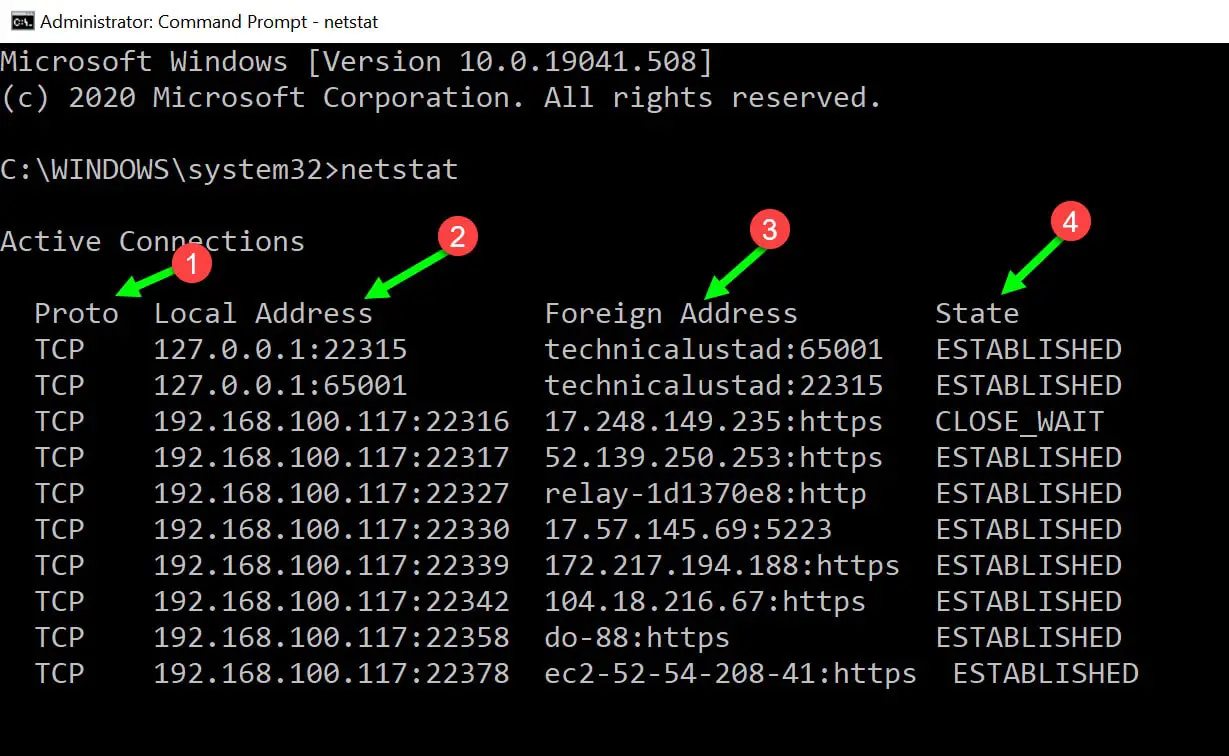
if you want to know from which website your PC is secretly connecting then use the command
netstat -abf
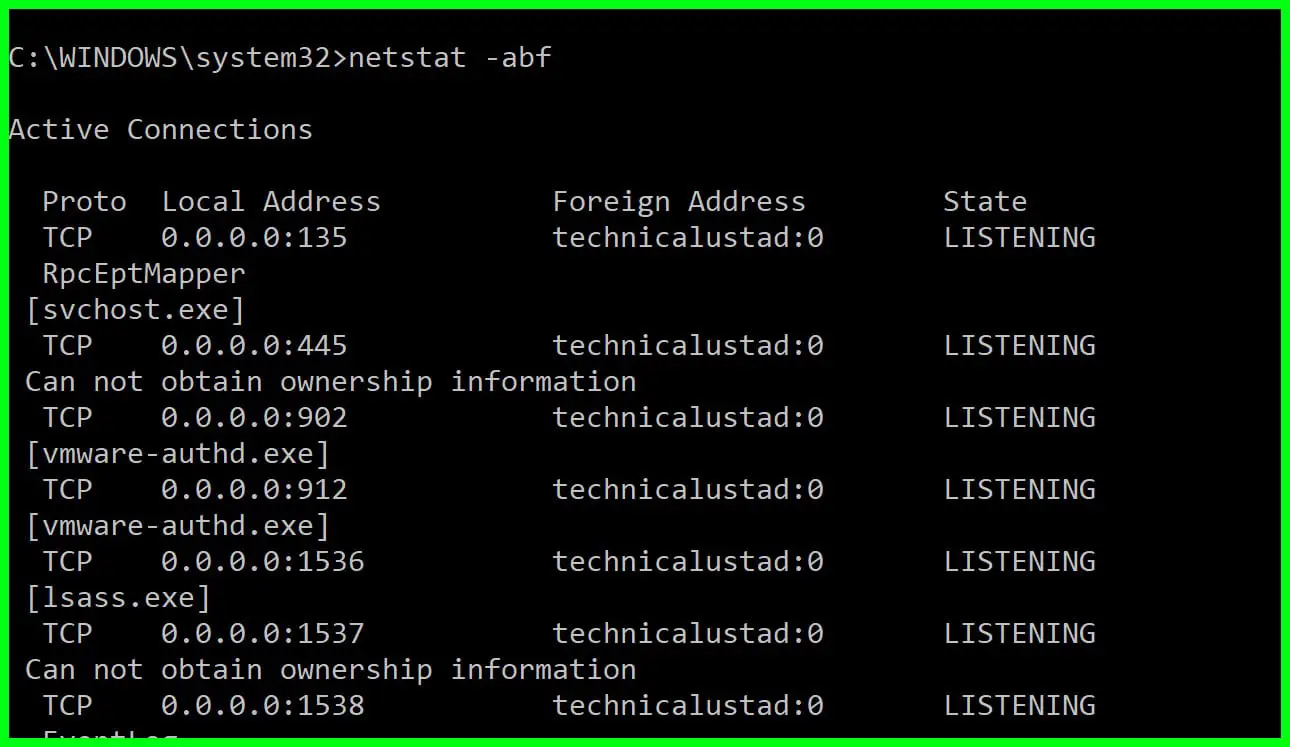
If you are looking for a GUI tool for this purpose then I will recommend you yo use the Currports tool (Download Here) from Nirsoft.
it will show you the same netstat information in the GUI view along with the command to kill it.
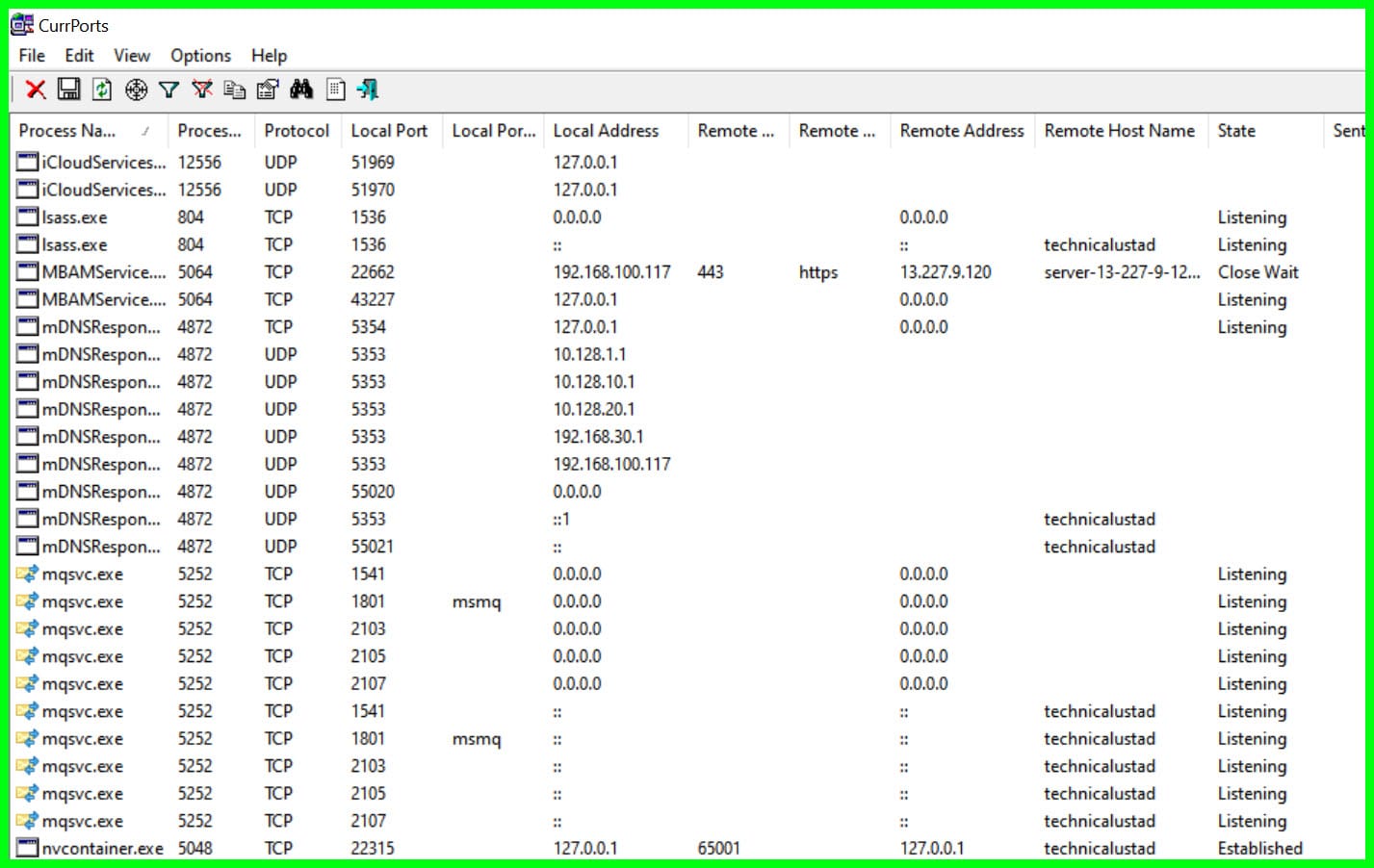
if you want to close the connection then just right-click on the particular connection select the kill connection option.
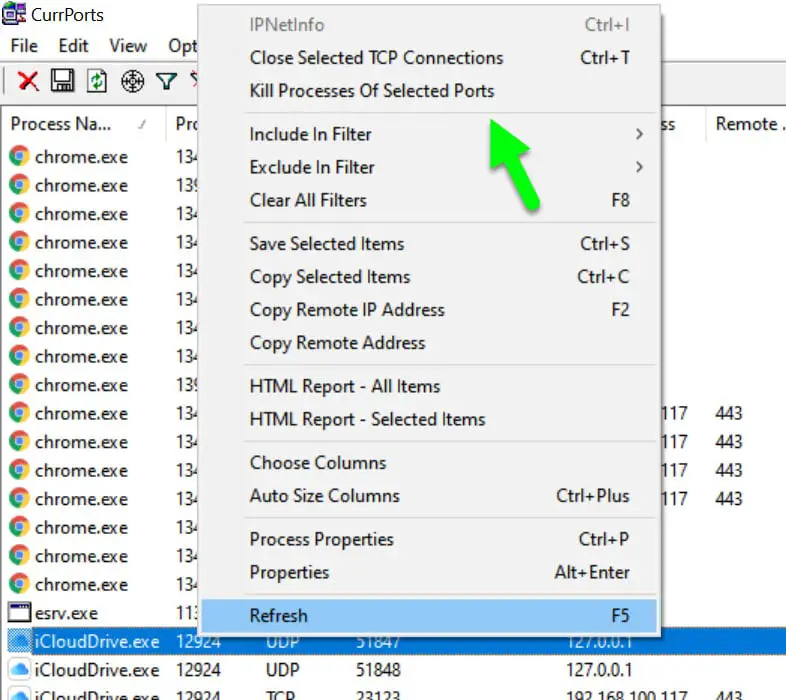
if you want to view the send and receive bytes of data by each connection then LiveTcpUdpWatch (Download Here) is your tool.
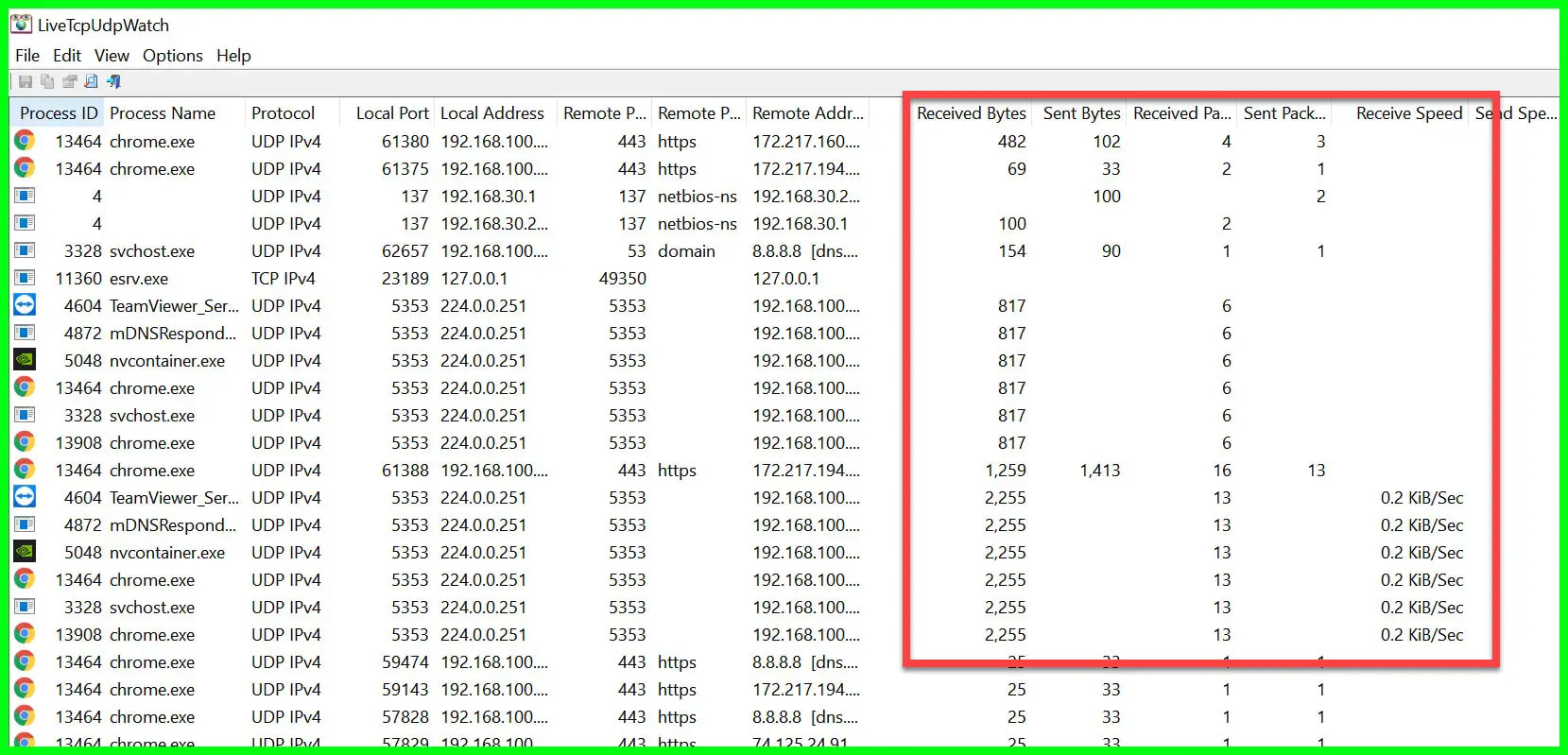
What Is The Difference Between TCP and UDP?
| TCP | UDP |
| Sequenced | Unsequenced |
| Reliable | Unreliable |
| Connection-oriented | Connectionless |
| Virtual circuit | Low Overhead |
| Acknowledgments | No Acknowledgments |
| Windowing flow control | No windowing or flow control |
| Parameter | TCP | UDP |
|---|---|---|
| Connection-oriented | Yes | No |
| Reliability | Reliable (guaranteed delivery) | Unreliable (no guaranteed delivery) |
| Ordering | In-order delivery | No guaranteed ordering |
| Congestion Control | Yes | No |
| Flow Control | Yes | No |
| Checksums | Yes (included in the header) | Yes (included in the header) |
| Acknowledgments | Yes, using acknowledgments | No acknowledgments |
| Packet Size | Variable | Fixed |
| Error Recovery | Retransmission of lost packets | No retransmission of lost packets |
| Usage | Suitable for reliable data transfer | Suitable for real-time and high-speed data |
Let’s break down the TCP and UDP in the simple language. TCP is like your mobile phone communication where you call a person and the receiver acknowledges the call by accepting it and after the acceptance, you start talking.
TCP is a mostly used communication protocol for web-browsing, email, Client-server communications.
But UDP is like a Postcard where you send the message to the address but you don’t know when it’s reached.
UDP is mostly used in the Voice call and gaming where you need speed.
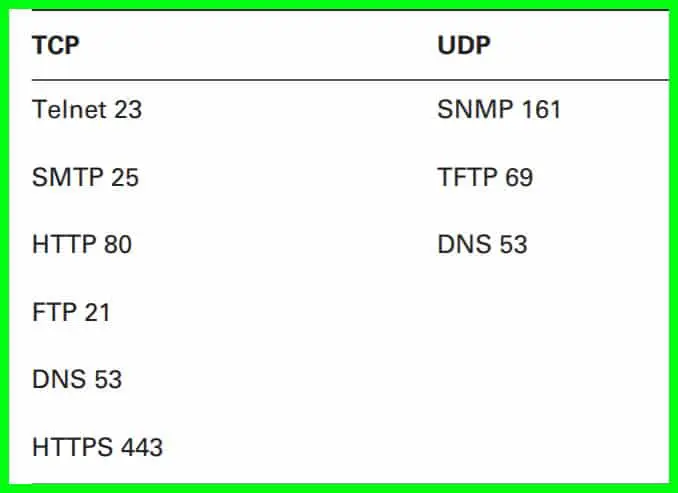
In our Difference Between TCP and UDP chart, all terms are self-explanatory except the virtual circuit.
let’s understand this, Most of us know that before you speak to someone on a phone, you must first establish a connection with that other person—wherever they are. This is like a virtual circuit with the TCP protocol.
Is TCP better than UDP?
It completely depends upon application requirement, If the application required fast connection like a Video call or gaming then UDP is better then TCP but where you need a reliable connection like web-browsing then TCP is better then UDP.
Where TCP and UDP are used?
Why UDP is faster than TCP?
What is the major difference between TCP and UDP packets Quizlet?
Is UDP secure?
What is the difference between the TCP and UDP Header?
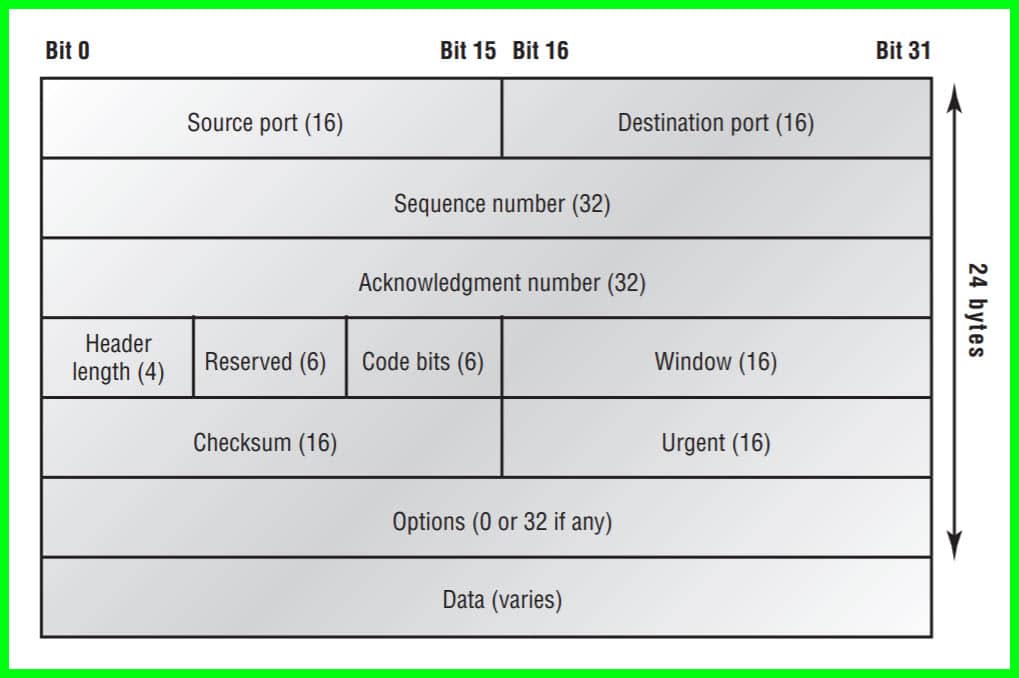
The TCP header is 20 bytes long, or up to 24 bytes with options. You need to understand what each field in the TCP segment is:-
Source port:- The port number of the application on the host sending the data. (Port numbers will be explained a little later in this section.)
Destination port:- The port number of the application requested on the destination host.
Sequence number:- A number used by TCP that puts the data back in the correct order or retransmits missing or damaged data, a process called sequencing.
Acknowledgment number:- The TCP octet that is expected next.
Header length:- The number of 32-bit words in the TCP header. This indicates where the data begins. The TCP header (even one including options) is an integral number of 32 bits in length.
Reserved Always set to zero.
Code bits Control functions used to set up and terminate a session.
Window The window size the sender is willing to accept, in octets.
Checksum The cyclic redundancy check (CRC), because TCP doesn’t trust the lower layers and checks everything. The CRC checks the header and data fields.
Urgent A valid field only if the Urgent pointer in the code bits is set. If so, this value indicates the offset from the current sequence number, in octets, where the first segment of non-urgent data begins.
Let’s first look at the UDP packet header,

It’s important for you to understand what each field in the UDP segment is:
Source port Port number of the application on the host sending the data
Destination port Port number of the application requested on the destination host
Length Length of UDP header and UDP data
Checksum of both the UDP header and UDP data fields Data Upper-layer data
Is it Possible to View the TCP Packet Header?
Yes, you can view the TCP packet header on your PC with the help of packet sniffer like WireShark (Download Here), after installation launch the application and select the interface that you are using.
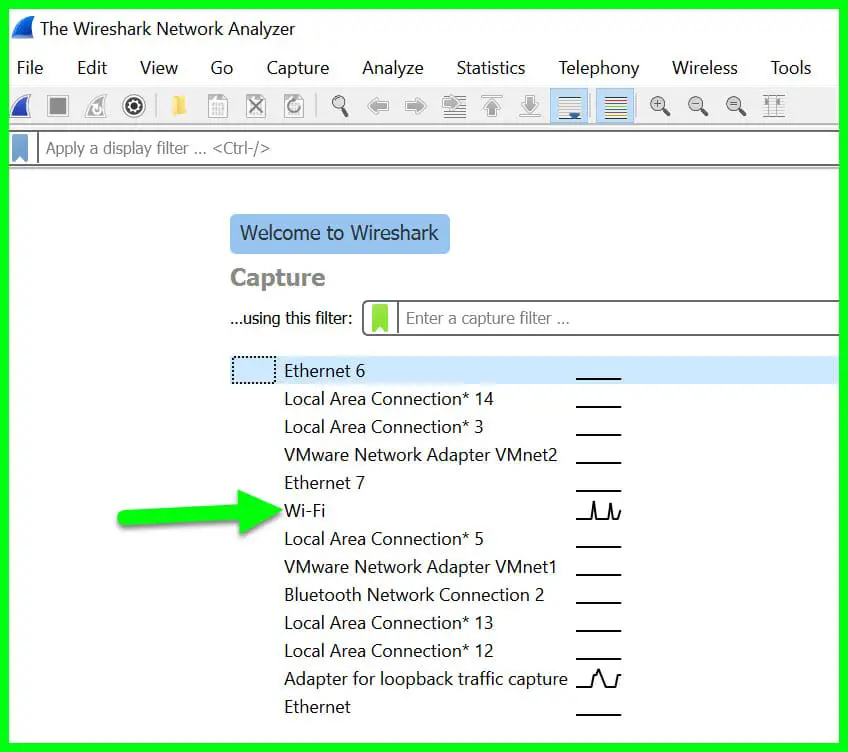
now it will start capturing your interface traffic. under the filter, option enters the TCP. Select any packet that you want to view the packet.
after selection, you will see the “Transparent Control Protocol” option.
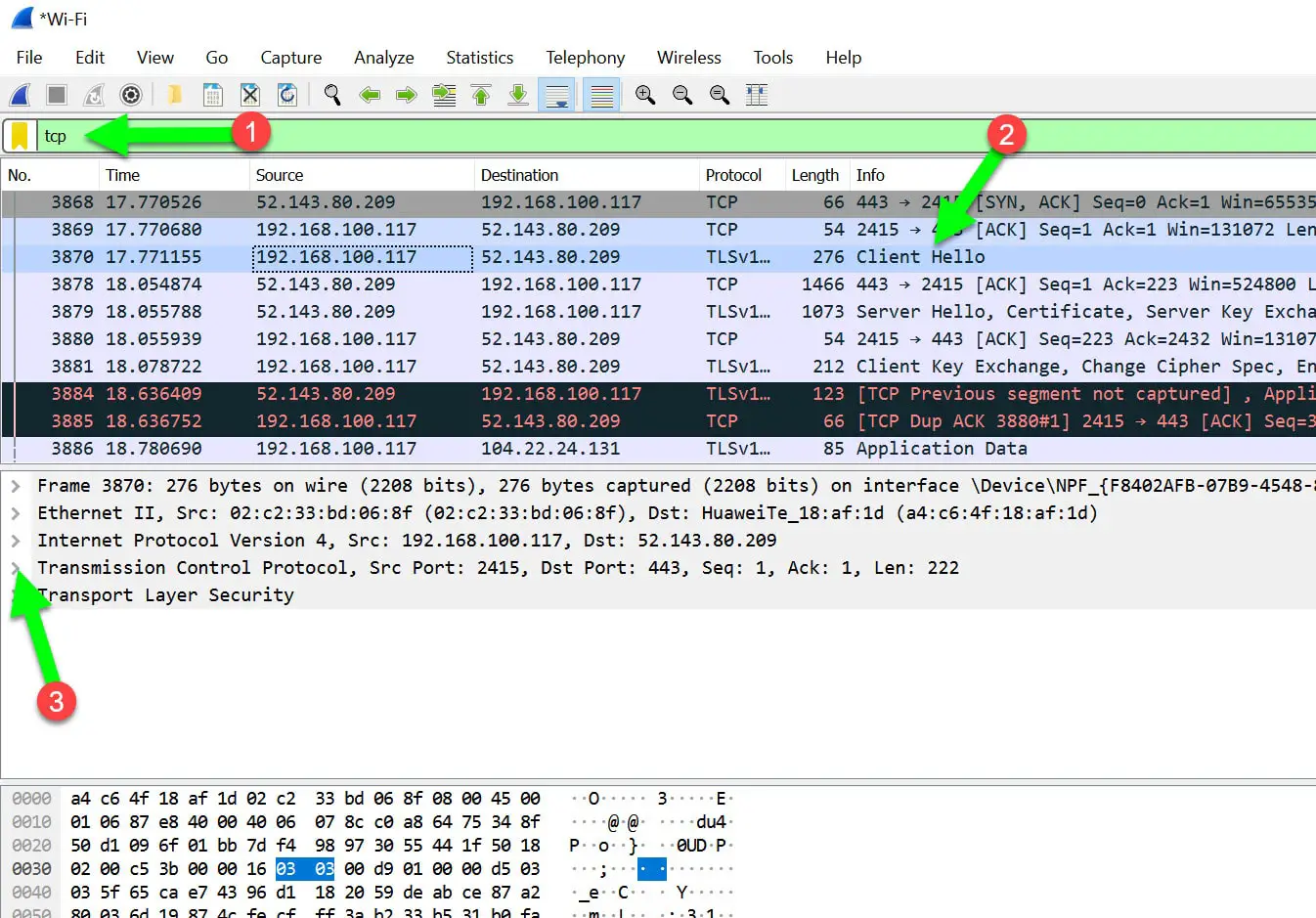
it will show you the TCP header information.
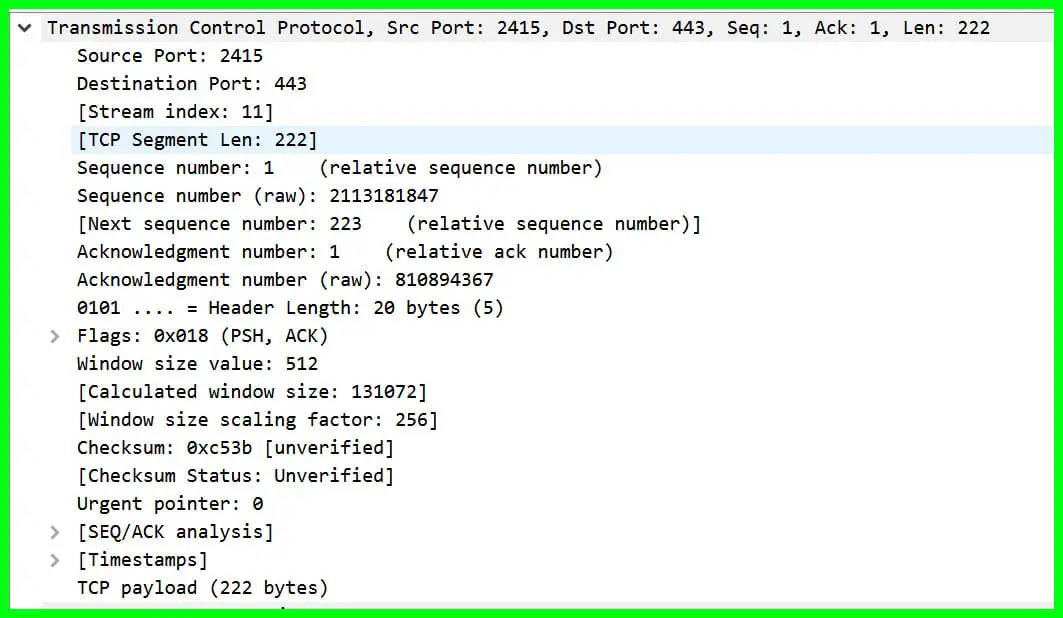
same way, you are able to view the UDP header.
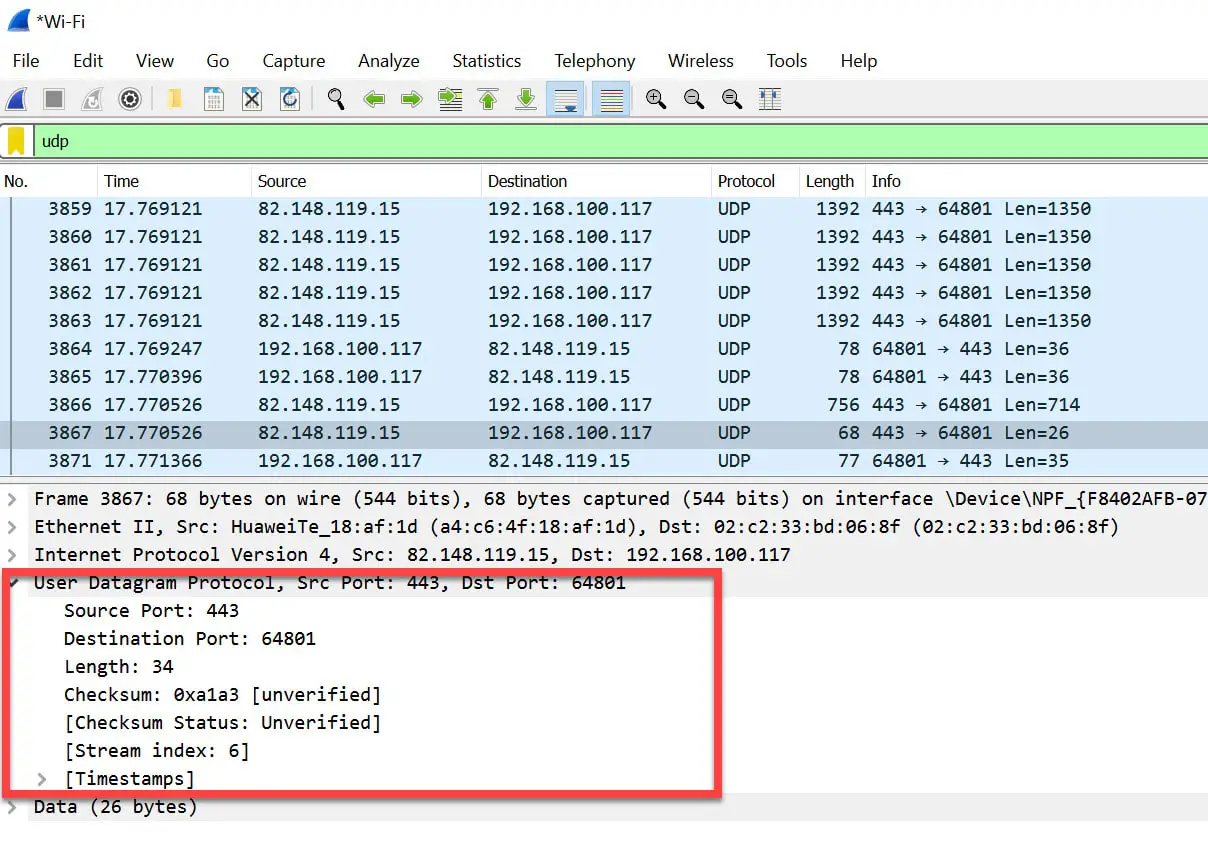
📗FAQ
What are the three differences between TCP and UDP?
Three differences between TCP and UDP are:-
- TCP is a connection-oriented protocol that provides reliable data transfer, whereas UDP is a connectionless protocol that does not provide guaranteed delivery of packets.
- TCP is slower than UDP due to its reliability, which involves additional overhead in error checking and retransmission of lost packets.
- TCP uses a three-way handshake to establish a connection, whereas UDP does not require any such mechanism.
What are TCP and UDP with example?
TCP (Transmission Control Protocol) and UDP (User Datagram Protocol) are two of the most commonly used protocols for data transmission over the Internet.
TCP is used for applications requiring reliable, ordered data delivery, such as email and file transfer protocols. In contrast, UDP is used for real-time applications such as video streaming and online gaming, where speed is more important than reliability.
An example of TCP is HTTP (Hypertext Transfer Protocol), which transmits web pages over the internet. An example of UDP is the Domain Name System (DNS), which translates domain names into IP addresses.
Why use UDP instead of TCP?
UDP is used instead of TCP when speed is more important than reliability, such as in real-time applications like video streaming and online gaming.
UDP provides faster data transmission because it does not require error checking and retransmitting lost packets, which can cause delays in TCP.
Is TCP more reliable than UDP?
TCP is generally considered more reliable than UDP because it allows error checking and retransmission of lost packets. This ensures that data is delivered in the correct order and without errors.
However, this reliability comes at the cost of speed, as TCP is slower than UDP due to the additional overhead involved in error checking and retransmission.
What is TCP vs UDP for dummies?
TCP is like a phone call where you converse with the other person and confirm that they have received the message. UDP is like sending a letter where you don’t get confirmation that the recipient has received it, but it gets there faster.
What is an example of UDP?
An example of UDP is online gaming, where speed is more important than reliability. In online gaming, the game server sends data packets to the players, which must be delivered quickly to ensure a smooth gameplay experience.
Another example of UDP is video streaming, where small delays in transmission are less noticeable than lost packets, which can cause buffering.
Does Netflix use TCP or UDP?
Netflix uses TCP for its video streaming service because reliability is more important than speed. TCP provides error checking and retransmission of lost packets, which ensures that the video is delivered without errors and in the correct order.
What are 5 common protocols that use TCP and UDP?
Five common protocols that use TCP are:-
- HTTP (Hypertext Transfer Protocol) – used for transmitting web pages over the internet.
- SMTP (Simple Mail Transfer Protocol) – used for sending email messages online.
- FTP (File Transfer Protocol) – used for transferring files between computers over the internet.
- SSH (Secure Shell) – used for secure remote login to a computer over the internet.
- Telnet – used for remote access to a computer over the internet.
Five common protocols that use UDP are:-
- DNS (Domain Name System) – used for translating domain names into IP addresses.
- DHCP (Dynamic Host Configuration Protocol) – used for assigning IP addresses to devices on a network.
- TFTP (Trivial File Transfer Protocol) – transfers files between computers on a network.
- SNMP (Simple Network Management Protocol) – is used for managing and monitoring network devices.
- VoIP (Voice over Internet Protocol) – is used for transmitting voice calls.
Why do we use UDP?
We use UDP because it is a fast and lightweight protocol suitable for real-time applications such as video streaming and online gaming, where speed is more important than reliability.
UDP does not provide error checking and retransmission of lost packets, which can cause delays, but this is not always necessary for certain applications.
What are the disadvantages of UDP vs TCP?
The main disadvantage of UDP compared to TCP is that it does not provide error checking and retransmission of lost packets, which can result in data loss and out-of-order delivery.
This makes UDP less reliable than TCP, which can be a problem for applications requiring guaranteed data delivery. Additionally, UDP is more susceptible to network congestion and packet loss, which can further reduce its reliability.
Does zoom use TCP or UDP?
Zoom uses both TCP and UDP for its video conferencing service. TCP is used for initial connection setup and control messages, while UDP is used for audio and video data transmission to ensure low latency and high quality.
Why can’t we use TCP as a transfer?
TCP can be used for file transfer, but it may not always be the best option. TCP’s reliability comes at the cost of speed, as it involves error checking and retransmission of lost packets, which can cause delays.
Additionally, TCP’s congestion control mechanism can further slow data transmission, especially over long distances or congested networks. UDP may be a better option for applications requiring faster data transfer and can tolerate some packet loss.
What is the main disadvantage of TCP over UDP?
The main disadvantage of TCP over UDP is that it is slower due to its reliability. TCP involves additional overhead in the form of error checking and retransmission of lost packets, which can cause delays in data transmission.
Additionally, TCP’s congestion control mechanism can further slow data transmission, especially over long distances or congested networks.
Is TCP or UDP better for streaming?
UDP is generally better for streaming than TCP because it is faster and can provide low-latency, high-quality audio and video data transmission.
TCP’s reliability comes at the cost of speed, as it involves error checking and retransmission of lost packets, which can cause delays in streaming.
What is the most important difference between TCP and UDP?
The most important difference between TCP and UDP is that TCP is a connection-oriented protocol that provides reliable, ordered data delivery.
In contrast, UDP is a connectionless protocol that does not provide guaranteed delivery of packets. TCP’s reliability comes at the cost of speed, as it involves error checking and retransmission of lost packets, while UDP is faster but less reliable.
Does DNS use TCP or UDP?
DNS uses both TCP and UDP for its operations. UDP is used for most DNS queries, which are small and can be transmitted quickly, while TCP is used for large DNS queries and zone transfers, which require reliable transmission of data.
What are 3 uses for UDP?
Three uses for UDP are:
- Video streaming – where speed and low latency are more important than reliability.
- Online gaming – where real-time interaction and speed are critical.
- VoIP – where real-time transmission of voice data is important and low latency is essential.
Is Youtube a TCP or UDP?
YouTube uses both TCP and UDP for its video streaming service. TCP is used for initial connection setup and control messages, while UDP is used for audio and video data transmission to ensure low latency and high quality.
Is wifi TCP or UDP?
Wi-Fi is a wireless networking technology that operates at the OSI model’s physical and data link layers, and can use both TCP and UDP for data transmission. Wi-Fi itself is not a protocol, but rather a means of connecting devices to a network wirelessly.
What is a real-life example of TCP?
A real-life example of TCP is email, which uses the SMTP (Simple Mail Transfer Protocol) to transmit email messages over the internet. TCP’s reliability ensures that email messages are delivered in the correct order and without errors.
Why is TCP not used for streaming?
TCP is not used for streaming because it is slower than UDP due to its reliability. TCP involves error checking and retransmitting lost packets, which can cause delays in streaming.
Additionally, TCP’s congestion control mechanism can further slow data transmission, especially over long distances or congested networks.
Can TCP and UDP use the same port?
Yes, TCP and UDP can use the same port number because they are different protocols with different port spaces. However, the applications that use TCP and UDP must ensure that they do not conflict and use the appropriate protocol for transmitting data.
Which ports use UDP?
Some common ports that use UDP are:
- DNS – port 53
- DHCP – port 67 and 68
- TFTP – port 69
- SNMP – port 161 and 162
- NTP – port 123
Why is UDP unreliable?
UDP is considered unreliable because it does not check errors and retransmit lost packets, which can result in data loss and out-of-order delivery.
UDP does not guarantee data delivery, but it is faster and more efficient than TCP for certain applications where speed is more important than reliability.
Does anything use UDP anymore?
UDP is still used for many applications that require fast and efficient data transmission, such as online gaming, video streaming, and VoIP. UDP’s speed and low latency make it ideal for real-time applications where reliability is less important.
What are the two weaknesses of the UDP packet?
Two weaknesses of the UDP packet are:
- Lack of reliability – UDP does not provide error checking and retransmission of lost packets, which can result in data loss and out-of-order delivery.
- Vulnerability to network congestion – UDP does not have a congestion control mechanism, which can cause network congestion and further reduce its reliability.
Do video calls use TCP or UDP?
Video calls can use TCP and UDP, depending on the application and the network conditions. TCP is used for initial connection setup and control messages, while UDP is used for audio and video data transmission to ensure low latency and high quality.
Is video calling TCP or UDP?
Video calling can use both TCP and UDP, depending on the application and the network conditions. TCP is used for initial connection setup and control messages, while UDP is used for audio and video data transmission to ensure low latency and high quality.
Does video calling use TCP?
Video calling can use TCP for initial connection setup and control messages, but it typically uses UDP for audio and video data transmission to ensure low latency and high quality.
Can we use TCP without IP?
No, TCP is a protocol that operates at the transport layer of the OSI model and requires IP (Internet Protocol) to provide network addressing and routing.
Is TCP used for Ethernet only?
TCP is not used for Ethernet only but is commonly used for transmitting data over IP networks, including Ethernet.
Can TCP only work over IP networks?
TCP is a protocol that operates at the transport layer of the OSI model and can work over any network that provides network addressing and routing, including IP networks and other types of networks.
What is three way handshake in TCP?
The three-way handshake in TCP is a process for establishing a connection between two devices. It involves three steps
- The initiating device sends an SYN (synchronize) message to the receiving device to request a connection.
- The receiving device responds with a SYN-ACK (synchronize-acknowledge) message to acknowledge the request and establish the connection’s parameters.
- The initiating device sends an ACK (acknowledge) message to confirm the receipt of the SYN-ACK message and to finalize the connection.
Why Netflix uses TCP but not UDP?
Netflix uses TCP for its video streaming service because reliability is more important than speed. TCP provides error checking and retransmission of lost packets, which ensures that the video is delivered without errors and in the correct order.
On the other hand, UDP does not provide guaranteed delivery of packets and is more susceptible to network congestion and packet loss.
Does VPN use UDP?
VPN (Virtual Private Network) can use both TCP and UDP for data transmission, depending on the VPN protocol and the network conditions. UDP is generally faster and more efficient than TCP, but it is less reliable and can be more susceptible to network congestion and packet loss.
Does Spotify use UDP?
Spotify uses both TCP and UDP for its music streaming service. TCP is used for initial connection setup and control messages, while UDP is used for audio data transmission to ensure low latency and high quality.
What is TCP, in simple words?
TCP (Transmission Control Protocol) operates at the OSI model’s transport layer and provides reliable, ordered delivery of data between two devices over an IP network.
TCP ensures that data is transmitted without errors and in the correct order, and it provides error checking and retransmission of lost packets to ensure reliability.
What is port 80 used for?
Port 80 is used for HTTP (Hypertext Transfer Protocol), which is used for transmitting web pages over the internet. Port 80 is the default port for web servers and is used for incoming requests from web browsers.
Is DHCP a TCP or UDP protocol?
DHCP (Dynamic Host Configuration Protocol) is a UDP protocol used for assigning IP addresses to devices on a network.
What runs on port 53?
Port 53 is used for DNS (Domain Name System), which translates domain names into IP addresses.
Which protocols use UDP?
Some common protocols that use UDP are:
- DNS – port 53
- DHCP – port 67 and 68
- TFTP – port 69
- SNMP – port 161 and 162
- NTP – port 123
Does HTTP use UDP?
No, HTTP (Hypertext Transfer Protocol) uses TCP for data transmission because reliability is more important than speed for web page delivery.
Does Facebook use TCP or UDP?
Facebook uses both TCP and UDP for its services, including its website and messaging platform. TCP is used for initial connection setup and control messages, while UDP is used for audio and video data transmission to ensure low latency and high quality.
Is UDP IPv4 or IPv6?
UDP can be used with IPv4 and IPv6, as it is a transport layer protocol independent of the network layer protocol.
Is a phone call UDP or TCP?
A phone call can use both UDP and TCP, depending on the application and the network conditions. UDP is typically used for real-time audio transmission to ensure low latency, while TCP may be used for initial connection setup and control messages.
Do IP phones use UDP?
Yes, IP phones use UDP for real-time audio transmission to ensure low latency and high quality.
How do I know if I have TCP or UDP?
You can determine whether a protocol is using TCP or UDP by examining the port number that it is using. TCP and UDP use different port spaces, and certain port numbers are associated with specific protocols.
For example, port 80 is associated with HTTP, which uses TCP, while port 53 is associated with DNS, which can use TCP or UDP.
Is TCP IP or Ethernet?
TCP is a protocol that operates at the transport layer of the OSI model and is independent of the physical layer protocol, which can include Ethernet.
Is UDP a IP or DNS?
UDP is a protocol that operates at the transport layer of the OSI model and is independent of the network layer protocol, which can include IP or DNS.
Does Netflix use UDP?
Netflix uses TCP for its video streaming service because reliability is more important than speed. TCP provides error checking and retransmission of lost packets, which ensures that the video is delivered without errors and in the correct order.
On the other hand, UDP does not provide guaranteed delivery of packets and is more susceptible to network congestion and packet loss.
What is an example of a UDP?
An example of a UDP is DNS (Domain Name System), which translates domain names into IP addresses. DNS queries are typically small and can be transmitted quickly, which makes UDP a good choice for this application.
When would you use UDP over TCP?
UDP is typically used over TCP when speed is more important than reliability. This can be the case for real-time applications such as online gaming, video streaming, and VoIP, where low latency is critical and some packet loss can be tolerated.
Is Netflix TCP or UDP?
Netflix uses TCP for its video streaming service because reliability is more important than speed. TCP provides error checking and retransmission of lost packets, which ensures that the video is delivered without errors and in the correct order.
On the other hand, UDP does not provide guaranteed delivery of packets and is more susceptible to network congestion and packet loss.
Why does VOIP use UDP instead of TCP?
VOIP (Voice over Internet Protocol) uses UDP instead of TCP because low latency and high quality are more important than reliability for real-time audio transmission. TCP’s reliability comes at the cost of speed, as it involves error checking and retransmission of lost packets, which can cause delays in transmission.
Can two IP addresses use same port?
No, two IP addresses cannot use the same port number for the same protocol because the port number is used to identify the application or service that is using the protocol. However, different IP addresses can use the same port number for different protocols.
What port number is 8080?
Port 8080 is an alternative to port 80 for web servers. It is often used for testing and development purposes.
How many ports can a server have?
A server can have up to 65,535 ports, which are divided into three ranges: well-known ports (0-1023), registered ports (1024-49,151), and dynamic or private ports (49,152-65,535).
What is the main advantage of UDP?
The main advantage of UDP is that it is faster and more efficient than TCP for real-time applications such as video streaming and online gaming. UDP does not provide error checking and retransmission of lost packets, which can cause delays, but this is not always necessary for certain applications.
What is UDP preferred to TCP?
UDP is preferred to TCP for real-time applications where speed and low latency are more important than reliability. This can include video streaming, online gaming, and VoIP.
What is the difference between a port and a protocol?
A port is a number used to identify the application or service using a protocol. In contrast, a protocol is a set of rules and procedures for transmitting data between two devices. A protocol can use multiple port numbers to identify different applications or services.
Conclusion
With our guide on What Is The Difference Between TCP and UDP protocol, we tried to cover up all the aspects of the protocol that a technical and normal user needs to know.
Overall TCP is a connection-oriented, Full-duplex, reliable, and secure protocol compared to the UDP protocol.
With this post, we didn’t only cover the differences but also you are able to view both the connection on your PC with Wireshark and other small nifty programs like currports and also you are able to view the connection with the netstat commmand.


























